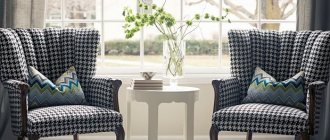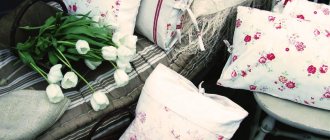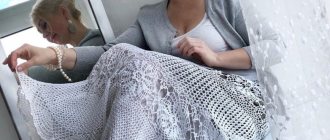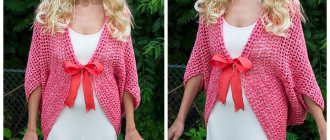If you are looking for wallpaper or textiles in the Provence style, you have probably already looked at many sites and formed your own idea. We can assume that it is something like this - it is wallpaper with floral motifs or light, plain; floral textiles, or natural, natural colors.
Among interior photographs there are repeating, especially recognizable designs that are not given special attention and are put in one general row. But, if you want to create the atmosphere of France in your interior, we advise you to pay attention to these designs. Because they are truly French and, moreover, they are the interior symbol of France - this is the Toile de Jouy.
Toile de jouy is literally translated as fabric from Jouy , in some cases, the phrase Toile de Jouy , as it is closer to the French pronunciation, but in our material we will use the combination Toile de Jouy , or simply Jouy.
In the combination of words, “fabric” refers not so much to fabric as a material, but to a special design that was initially printed on cotton fabric, and is now used as a design element in other materials.
Story
For information about the history of fabric, articles, photographs from the website, mobile application and social accounts of the Toile de Jouy Museum were used.
Painted cotton fabrics came to Europe from India around the end of the 17th century. Large imports provided serious competition to local producers of silk and cotton fabrics, and France, embroiled in wars, required taxes. To protect French manufacturers, in 1759 the King of France ordered a complete ban on the import of textiles throughout France. But people have already fallen in love with bright Indian fabrics with beautiful patterns, flowers, and exotic animals. To satisfy the created demand, the only way out was the development of production in the country.
In 1760, in the west of Paris, not far from Versailles, in the village of Jouy-en-Josas, a manufactory for the production of cotton fabrics was founded. The production was founded by the engraver and printer Christoph-Philippe Oberkampf, a German by birth, who immigrated to France:
Beautiful and high-quality fabrics ensured a good reputation for the manufactory, and in 1783 it received the title “Manufacture Royale”.
The first motifs in fabrics were flowers and abstract patterns, popular in those days. Designs known in the future, with monochrome and color plot drawings, constituted only a small part, but soon they came into fashion and formed the basis for the production of his stylish handwriting:
In 1785 Christoph-Philipp Oberkampf invented a printing press for printing wallpaper.
In 1787, King Louis XVI sent Christophe-Philippe Oberkampf a letter of gratitude for his participation in the design of the royal palace. After this event, the paintings on the fabric of the Oberkampf manufactory received the official name Toile de Jouy as an element of style (in our opinion, a design element):
In 1807, Christoph-Philippe Oberkampf received the Legion of Honor badge, and Napoleon Bonaparte personally visited the manufactory:
The popularity of Toile de Jouy is largely due to the attention to the design of the drawings; they represented subjects that involved the imagination.
Stories from people's lives:
Events:
And, of course, love:
Both unknown beginning artists and famous ones, such as the painter Jean-Baptiste Huet, took part in the creation of the drawings:
Towards the middle of the 19th century, the fashion for Toile de Jouy died out. In 1843 production stopped.
In 1977, the Toile de Jouy Museum was opened. The museum presents the history of production, an archive of designs, installations of historical interiors, and modern examples of designs.
When we talk about Toile de Jouy as a design element, we do not mean the entire series of drawings and patterns that were used by the manufactory, but specifically monochrome or color drawings.
Ruyi's design is used in clothing, shoes, haberdashery:
And also in interior design: furniture upholstery, home textiles, wallpaper.
Toile de Jouy: a classic French style
Grace of fine lines, sophistication, unique charm - these epithets perfectly characterize Toile de Jouy. When cotton with a mesmerizing monochrome pattern first fell into my hands, the rest, even the brightest, fabrics faded against its background. It was from this moment that my passion for this sophisticated style began. In this publication I will try not only to show all the charm of Toile de Jouy, but also to supplement the selection with interesting historical facts.
1. Initially, the term “Toile de Jouy” did not mean an interior style, but a specially designed thin fabric that was produced at a factory in the village of Jouy-en-Jouy, not far from Versailles (Toile de Jouy literally from French This is how it is translated - “fabric from Zhuy”). It was usually white or cream-colored linen or cotton, decorated with a printed monochrome pattern that was repeated over the entire surface of the fabric.
2. The factory in the village of Jouy-en-Josa was founded in 1760 by the French-German industrialist Christoph-Philippe Oberkampf. The location was chosen because of the chemical properties of the water in the Bièvre River, which flows in Jouy-en-Josat, allowing for good washing of fabrics.
3. Most often, the fabric depicted idyllic pastorals, episodes of game hunting, scenes from ancient mythology and history. Ladies and gentlemen on a picnic; a shepherd playing the flute, and sheep grazing peacefully nearby; a pretty, cheerful girl picking fruit; a walk in a secluded corner of the garden - this is not a complete list of subjects used. By the way, the motives of modern ruyi have practically not changed.
4. Of course, artists who created a variety of prints played an important role in the process. Among them, Jean-Baptiste Huet became especially famous for his pastoral scenes in the Rococo style.
5. It should be noted that the historical Ruyi fabric is the result of long and painstaking work by craftsmen. First, the material was soaked in running water, dried in the sun and passed between rollers to make its surface smooth. Then, using acid, a colorless background pattern was printed onto the fabric. The fabric was cleaned of excess chemicals and immersed in a solution of plant origin that produced blue, purple, pink or red colors. Finally, special wax was applied, again passed through rollers and polished for a long time with a crystal or agate ball.
6. During the time of King Louis XIV, the popularity of Toile Jouy was unusually great. This contributed to the fact that the name “Toile de Jouy” became a common noun for all fabrics of this type (even those that were not produced in the village of Jouy).
7. Jouy fabrics were most often used to make various textile interior elements (wallpaper, upholstery, curtains, lampshades). These fabrics were mandatory in the decoration of bedrooms, living rooms and other rooms of the noble population.
8. Thanks to the excellent quality of printed fabrics, the factory was considered one of the best in Europe. The success was dizzying, but, alas, did not last long. In 1843, the company, unable to withstand competition from new factories, declared itself bankrupt. Today, all that remains of the famous factory is a museum in the town of Jouy-en-José (see photo), where nearly five thousand exhibits are stored: fabric samples, some documentation and templates for printing designs.
9. Over time, the term “Toile de Jouy” often began to be used to describe a certain style in the interior, which harmoniously combines simplicity with aristocratic elegance. And not only fabric, but also various decorative items began to be decorated with monochrome prints.
10. Today, the Toile de Jouy style is experiencing a new surge in popularity. It is ideal for decorating interiors in French classic and provincial styles.
Thank you all for your attention and see you again!
All
Toile de Jouy and Provence style
Toul de Jouy is distinguished as a separate interior style, in which the motif is repeated in wallpaper, textiles, and decor. But, in the subjective opinion of the author, such an interior is overloaded with the frequency of repetitions and an abundance of drawings. Therefore, Toile de Jouy designs are used in interiors as a French design element, including French country, which in our area is called “Provence”.
Properties of Toile de Jouy motifs
Drawings in Jouy's designs have properties: activity, emphasis, rhythm.
Activity is the overall impression that a design creates. The active background attracts attention:
The emphasis is on the gaze; when examining the room, be sure to stop at the drawings to consider the details:
Rhythm - an alternating plot pattern will force the eye to move from picture to picture:
The use of Toile de Jouy designs in combination with other elements in the interior depends on what kind of interior we ultimately want to achieve.
Romance of the French province
Jouy's designs will help create a unity of history and modernity in the interior, so that the overall picture creates the impression of a different historical era, and modern objects and equipment do not stand out.
Plot balance. Drawings with people from another era will create a balanced plot unity, in combination with antique or modern furniture and decor made in the old style.
Colour contrast. For contrast, you can use wallpaper with a dark pattern on a white background in combination with light furniture.
Contrast of patterns. The Provence style is a successor to the Baroque style, which uses many ornate and symmetrical patterns. Some of the patterns in de Jouy's designs are asymmetrical, creating a florid contrast.
Toile de Jouy's motifs of 19th-century village life will enhance the effect of provincial France in your interior.
French charm in a modern setting
In modern interiors, Toile de Jouy designs are used to create a French atmosphere, visual effects, contrast with modern furniture and furnishings.
A touch of France in the interior - the Provence style in a modern combination often does not have bright French elements. The missing part will be completed by de Jouy's design.
Visual effect - Toile de Jouy's drawings set a visual rhythm, this will enrich the interior without additional decor. Light wallpaper with a de Jouy pattern is used to visually increase space. For example, for a kitchen with a small area, you can use light blue patterns; this will enrich the look of the interior, set a French motif, and visually increase the space.
Rhythm - Creates mood and visual variety:
For those who love the lightness of color, smooth shapes and lines of Provence, but are not ready for a frankly rustic style.
Possible mistakes
Zhui's drawings are a complex decor; if you don't know, you can make the interior heavier. We hope our tips will help you avoid mistakes.
It is undesirable to allow simultaneous combinations of patterns of different themes, colors and sizes in the same interior. If you choose Toile de Jouy wallpaper for the walls, then as textiles you need to use: either the same pattern of the pattern, or a pattern of a different pattern, but in the same color , only different proportions of the drawing are permissible. In the case of combining Jouy's drawings of different colors and subjects, you risk getting an imbalance and a general overload of the interior composition.
You cannot combine Toile de Jouy wallpaper with other active designs or patterns. It is much better to use either plain motifs or motifs of inactive geometric shapes. For example, it is better to combine wallpaper with small Toile de Jouy patterns with wallpaper with wide stripes.
It is not advisable to use different Toile de Jouy themes in textiles, wallpaper, or furniture upholstery. If you choose curtains with Toile de Jouy motifs, then it is better to use floral designs, geometric patterns or plain backgrounds in wallpaper. The same rule applies to furniture:
It is not advisable to use wallpaper with a small pattern on a single, large open wall. This will visually enlarge the wall relative to other objects and make it look even more lonely, and the abundance of drawings will dazzle your eyes.
In addition to these errors, you need to take into account the rules of harmonious combinations.
Kitchen in Toile de Jouy style
The traditional French style with printed fabrics looks bright, advantageous and harmonious in the kitchen interior. The ideal combination is a bright and cozy kitchen in a provincial Provence style and blue and light blue prints applied to milky wallpaper, curtains, and lambrequins. It’s great if the kitchen is located on the sunny side and is illuminated by sunlight most of the day.
You can decorate a room in this style both in a country house and in a small apartment - the abundance of light and blue shades makes the space visually larger.
Additions to ideas - men's style
If men object that Ruyi’s drawings are too feminine, then in this section we will dispel their doubts:
Use wallpaper with a strict graphite or dark green pattern, aged brutalist furniture, add a master chair; men's furnishings are ready:
Let's add ideas to the men's theme:
Fishing corner - take an old bamboo fishing rod, a Neva reel, and add an exhibition of old fighting lures.
Hunting corner - take an old game bag, a hunting bugle, decoys, a hunting hat. A few ideas and fantasies, and you have a fishing or hunting area with history.
Toile de Jouy's motifs will create the necessary background for a men's interior.
Business style
The “toile de Jouy” print will add fragility and grace to the strict wardrobe of a business woman. To look correct, limit yourself to one thing with a pattern - wear a skirt, jacket or throw on a scarf. Complete the look with a plain blouse and neutral-colored accessories.
Why French children behave well: eight ways to raise them
Women's jeans: before you buy them, you need to pay attention to one detail
A student at the Vietnam Police Academy shared how she takes care of her facial skin.
Bottom line
What distinguishes the Provence style from other country styles is the atmosphere of France. Interior design connoisseurs love to find mistakes in styles. For example, in the Provence style - using typical Italian furniture instead of French. Particularly favorite mistakes are over-the-top and hackneyed associations, like lavender bouquets. With which you can please your interior only in the summer, if you’re lucky, of course, and we find where to buy lavender.
Toile de Jouy's design elements will create a truly strong French accent in your interior.
Evening dresses
The translation of the name Toile de Jouy from French is “fabric from Jouy”. The term was derived from the name of the village of Jouy-en-Josas near Versailles, where the pattern was invented. The design depicting landscapes and pastoral scenes is inspired by Chinese porcelain, which was a favorite of the European aristocracy of the 17th-18th centuries.
The toile de Jouy fabric is reminiscent of fine ceramics. Subtle patterns of blue, red, and black are applied to a light background. The pattern looks aristocratic and fits into the design of evening dresses with full skirts and necklines.
Where can I buy
Wallpaper
See wallpaper catalogs on the website of the online store oboivdom.by, and here you can also order samples of wallpaper by mail and buy the wallpaper you need with delivery. Delivery: to Belarus, Russia, Ukraine, Kazakhstan.
Wallpaper and textiles
Look at the wallpaper and textile catalogs on the website 7x7.by, and samples in the 7x7 showroom. Salon address: Minsk, Lozhinskaya street, building 4, on the first floor of a business building, with a separate entrance from the street.
Useful articles on the topic wallpaper
How to choose wallpaper. How to decide on wallpaper design. Read the article that breaks down the design point by point.
Subscribe to notifications of new publications by email or on social networks:
| Add to our groups on social networks: |
Palette and motifs
The classic colors used to create Toile de Jouy fabrics are pink, red or purple. The main themes used for images on fabric were pastoral themes, floral prints, historical and antique subjects. The pattern was repeated over the entire surface of the material. The Ruyi style was originally used in both interior design and clothing. Wallpaper, upholstery for upholstered furniture, tablecloths and napkins, and canopies for the bedroom were chosen in a similar style.







